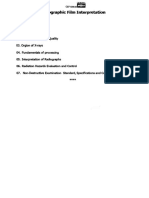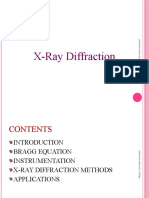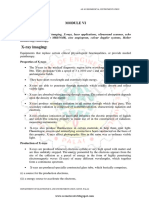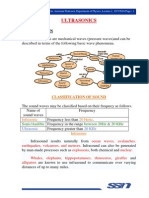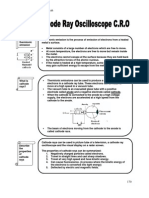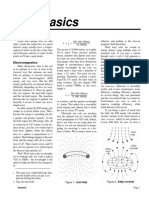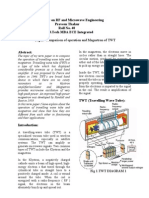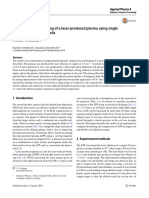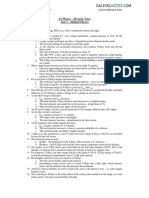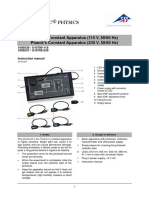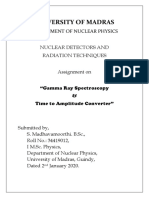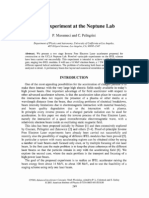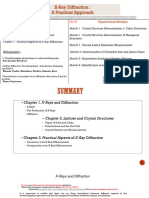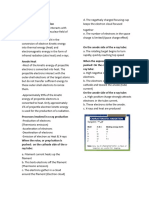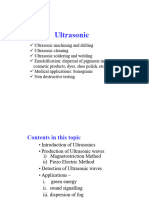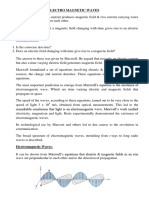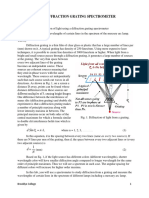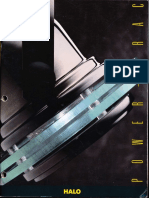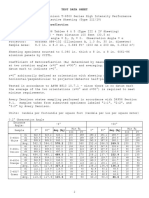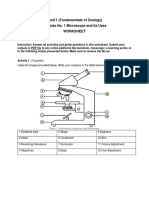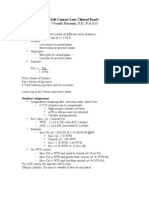B22: X-Ray Diffraction: 22.1 Objectives
B22: X-Ray Diffraction: 22.1 Objectives
Uploaded by
Daniel DolingCopyright:
Available Formats
B22: X-Ray Diffraction: 22.1 Objectives
B22: X-Ray Diffraction: 22.1 Objectives
Uploaded by
Daniel DolingOriginal Title
Copyright
Available Formats
Share this document
Did you find this document useful?
Is this content inappropriate?
Copyright:
Available Formats
B22: X-Ray Diffraction: 22.1 Objectives
B22: X-Ray Diffraction: 22.1 Objectives
Uploaded by
Daniel DolingCopyright:
Available Formats
Royal Holloway, University of London PH1140/1150 Scientific Skills Department of Physics
B22: X-ray diffraction
22.1 Objectives
The objectives of this experiment are ‘
• To investigate the nature of the X-ray spectrum pro-
duced when high energy electrons strike a copper tar-
get.
• To investigate X-ray fluorescence and the effects of
various absorbers.
Q1 Look through the rest of the script, then summarise
briefly the aims of the experiment and the ways in
which you intend to achieve them. This may well be
best done by making a bulleted list highlighting the
important points.
22.2 Review of the nature of X-rays
(For more detailed information, see Young and Freedman,
or Giancoli). Figure 22.1: X-ray tube
X-rays are electromagnetic waves whose wavelengths are
a factor of some 103 to 104 shorter than the wavelengths
of visible light. The wave-like nature of X-rays does not
explain all the properties of X-rays and, under certain ex-
perimental situations, they are best described as particles or
photons which travel at the velocity of light c and carry both
energy and momentum. If the frequency of the radiation is
f then the energy E of these photons is
E = hf
where h is Planck’s constant.
An X-ray tube is shown in Figure 22.1. A high voltage is
placed between the cathode and anode in an evacuated glass
tube. The cathode is heated and the thermionically emitted
electrons are accelerated towards the anode. The bombard-
ment of the anode by the high energy electrons results in the
emission of X-rays. The tube used in this experiment has a
copper anode at a voltage of 30 kV.
The X-rays emitted from the tube have a range of wave-
lengths and a schematic graph of energy intensity per unit
wavelength, I, versus wavelength, λ , is shown in Figure
22.2. The X-ray spectrum consists of a continuous distribu- Figure 22.2: X-ray spectrum
tion of radiation upon which are superimposed intense lines
characteristic of the copper anode.
The continuous radiation is produced when the electrons
are decelerated on striking the anode. These X-rays have
the minimum wavelength λM when all the kinetic energy of
an incident electron is converted to electromagnetic energy.
B22: X-ray diffraction 1 VA 11/1/2020
Royal Holloway, University of London PH1140/1150 Scientific Skills Department of Physics
pre-set, and should not be adjusted. The tube is shielded by
a lead-glass dome in which is mounted a 1 mm-wide lead
slit which produces a collimated ribbon beam of X-rays.
22.3.1 Carriage Arm
The carriage can be rotated about the central axis of rotation
and its angular position relative to the incident X-ray beam,
2θ, is given by the outer scale marked from 10◦ to 130◦ .
By means of internal gearing, the angular rotation of the
carriage arm is twice that of the crystal so ensuring that the
required geometry for Bragg diffraction is maintained as the
arm is rotated.
The carriage arm is normally rotated by using the orange
Figure 22.3: “The TEL-X-ometer” X-ray spectrometer manual control and a “no-parallax” reading of its position
on the 2θ scale is given by the double red-marker lines. For
Q2 Calculate the frequency corresponding to an energy of fine adjustment an aluminium thumb wheel is used. First,
30 keV. the arm is aligned accurately on any desired 2θ graduation,
the manual control is then held rigidly in this position while
Q3 Calculate the corresponding minimum wavelength, the thumb wheel is slipped until the zero of the wheel is
λM , in nm. aligned with the pointer. The thumb wheel can now be used
to move the arm ±4◦ about the preset position and its posi-
Q4 How does this wavelength compare with that of visible
tion read to ±5′ .
light?
The characteristic radiation is produced when an electron 22.3.2 GM-Tube, Scaler and Ratemeter
in an atom in the copper anode is ejected from its atomic en-
ergy level or shell by one of the accelerated electrons. An- The GM-tube can be connected either to a timer/counter or
other atomic electron, in a higher energy level, falls into the a ratemeter. The timer/counter counts the number of X-ray
vacancy created, thereby emitting an X-ray photon whose photons detected during a preset time. Since this time can
energy is equal to the difference between the two levels. be increased as desired, accurate count rates (the number of
The radiation produced is characteristic of the metal, in this counts per second) can be measured. A less accurate but
case copper, of the anode. In this experiment we will be continuous measurement of the count rate can be measured
concerned with the Kα and Kβ lines which arise from tran- with the ratemeter. This is sometimes more convenient; for
sitions from the L to K shells and from the M to K shells instance, when trying to find the position of an intense char-
respectively. The K shell is the lowest energy shell (i.e. the acterstic X-ray line. Both the timer/counter and ratemeter
electrons in the K shell are the most tightly bound in the supply the necessary DC voltage to operate the GM-tube,
atom by the Coulomb attraction of the nucleus), while the L typically about 410 V.
and M shells have higher energies.
22.4 Experiments on the characteristic radi-
22.3 The X-Ray spectrometer ation of Cu
The X-ray spectrum may be analyzed using an X-ray spec- Identify and list any potential hazards associated with this
trometer. The instrument used in this experiment is the experiment. Who are the persons at risk? What are the
TEL-X-ometer, a diagram of which is given in Figure 22.3. existing control measures and are they sufficient?
For a clear view of the various components raise the perspex The aim is to observe the X-ray emission from Cu, and to
scatter shield by moving it bodily sideways to disengage a use X-ray diffraction to measure the wavelengths of the Kα
spigot and keyhole locking arrangement located just behind and Kβ radiation. This is done by looking at the diffraction
the aluminium nameplate. The shield can now be raised of X-rays from a LiF crystal.
from the front about the rear hinges and left in a vertical
position. 22.4.1 Mounting the crystal
Only when the scatter shield is in its central locked po-
sition can the HT to the X-ray tube be energised. Moving A lithium fluoride, LiF, crystal is stored in a small glass tube
the shield sideways automatically cuts off the supply. This containing pieces of silica gel which absorb any moisture in
ensures that at no time can X-rays be produced while the the tube, since LiF is deliquescent. Lithium fluoride (LiF) is
shield is raised. a controlled substance, which may irritate the skin. Please
The X-ray tube is towards the rear of the instrument and use the tongs and gloves provided when handling After use,
the copper-disc anode is clearly visible. The tube current is the crystal must be replaced in the tube. Examination of
B22: X-ray diffraction 2 VA 11/1/2020
Royal Holloway, University of London PH1140/1150 Scientific Skills Department of Physics
of 40◦ , where the emission peaks are situated. If you do
not see such a rise, try reversing the crystal in its mounting
and test again. Once you have seen whereabouts the high
count region is, switch off the ratemeter, disconnect the G-
M tube from it, connect the G-M tube to the counter/timer
and switch on the counter/timer.
Since the count statistics will have a Poisson distribution,
the relative accuracy of a measured count rate will depend
on the total number of counts N. The√standard deviation
associated with a total count of N is ± N. Thus, the frac-
tional uncertainty is
√
Figure 22.4: LiF crystal mounted on crystal post N 1
± = ±√
N N
the two larger rectangular faces of the crystal will show that During the experiment ensure that for all your readings
one of these faces has a matt appearance while the other is N > 400 so that the uncertainty is no more than 5%. [Except
shiny. The matt surface must be used as the reflecting face. at the lower angles of diffraction, you will probably find that
Figure 22.4 shows how the crystal is mounted so that the a 10 second count period will be adequate. Note that if you
reflecting face is coincident with the central axis of rotation. find that the count at a particular angle is too small, all you
Ensure that the crystal is vertical and flat on the step of the have to do is to count for a further period of time and add
crystal post. The crystal post is attached to a slave plate (see the counts together, noting, of course, the new total time!]
Figure 22.3) on which are inscribed two lines. Around the
outside of this plate are two scales marked 60◦ − 0 − 60◦ . Q5 Check that the θ = 0◦ is lined up correctly. Measure
The angular position of an inscribed line on one of these and tabulate the count rate up to about 5◦ on either
scales gives the angle (the Bragg angle) which the incident side of the ‘interesting’ region. Use steps of 1◦ at a
X-ray beam makes with the reflecting face of the crystal. minimum and take more data points round the position
of the two large peaks which should be observed.
22.4.2 Measurements
Q6 Plot by hand a graph of count rate, n, versus 2θ. Don’t
Important Safety Warning High voltages are applied to forget to include error bars on your graph.
the GM counter. Do not open any high voltage supply or
disconnect any cable while the HT is switched on. Call a
More precise measurement of the angles of the peaks
demonstrator if you suspect any problem.
The wavelength, λ, of X-rays diffracted through a Bragg
• Check that the carriage arm is on the correct side of the
angle is given by
central position so that the GM-tube is pointing at the
2d sin θ = pλ (22.1)
(matt) reflecting face of the crystal.
where d is the separation of the “reflecting” atomic planes
• Connect the Geiger-Muller tube to the ratemeter.
of the LiF crystal. The crystal has been mounted so that the
• Lower the scatter shield and move it bodily to the cen- principal planes diffract the X-rays for which
tral locked position.
d = (0.2018 ± 0.0001)nm.
• With the mains connected, depress the ”POWER ON”
switch on the front panel. The order of diffraction, p, can take the values 1, 2, 3, etc.
However, the intensity of the higher orders is so low that the
• Turn the timer knob on the side of the apparatus fully
effective count rate at any angle is due to the first order, p =
clockwise.
1. Since n is proportional to the intensity, n versus 2θ , is, in
• Depress the red button “X-RAYS ON” If the red lamp effect, a plot of intensity versus wavelength and your graph
at the rear of the spectrometer does not come on, check should be similar to that shown in Figure 22.2. However,
that the shield is correctly centred and again depress due to randomly scattered background radiation the count
the red button. The HT can be turned off either by rate or intensity does not fall to zero for wavelengths less
moving the scatter shield sideways or by using the than λM .
”POWER ON” switch.
Q7 Disconnect the GM-tube from the timer/counter and
connect it to the ratemeter. Using the fine adjustment
Plotting the characteristic curve
accurately measure the positions and uncertainties of
Move the carriage arm and observe the rate. You should see the maxima of the two characteristic lines. These lines
it rise sharply when the carriage arm angle is in the region arise from the Kα and Kβ X-radiation of copper.
B22: X-ray diffraction 3 VA 11/1/2020
Royal Holloway, University of London PH1140/1150 Scientific Skills Department of Physics
Q8 Calculate the wavelengths (and uncertainties) of the
Kα and Kβ lines for copper from the measured Bragg Table 22.1: Wavelengths in nm for emission and absorption
angles using Equation (22.1). At Element Kα Kβ K
no. emission emission absorp-
The energy, E, of X-rays generated from a particular tar- Z tion
get is approximately given by edge
23 Vanadium V 0.255 0.228 0.227
( ) 24 Chromium Cr 0.229 0.208 0.207
hc 1
E = hf = = (Z − 1) 1 − 2 × 13.6 eV
2
(22.2) 25 Manganese Mn 0.210 0.191 0.189
λ l
26 Iron Fe 0.194 0.176 0.174
where Z is the atomic number of the element (i.e. the num- 27 Cobalt Co 0.179 0.162 0.161
ber of protons in the nucleus). For l = 2, E corresponds to 28 Nickel Ni 0.166 0.149 0.148
Kα radiation while l = 3 gives Kβ radiation. 29 Copper Cu 0.154 0.139 0.138
30 Zinc Zn 0.144 0.129 0.128
Q9 Compare your experimental results with the theoret-
ical values calculated from Equation (22.2). [The
atomic number of Cu is 29.]
22.5 Experiments on X-ray absorption edges
22.5.1 The characteristic radiation of different ele-
ments
In this experiment, characteristic X-rays from several ele-
ments are examined. To avoid the necessity of using dif-
ferent targets in the X-ray tube, the phenomenon of X-ray
fluorescence is used. This occurs when X-rays fall on a par-
ticular material. If the energy of the incident X-ray pho-
tons is larger than the energy required to eject an electron Figure 22.5: Arrangement with the foils
from the K shell, then vacancies will be produced in the K
shell. Subsequently, electrons from the L and M shells can
‘fall down’ into these vacancies, emitting the Kα and Kβ
radiation characteristic of the absorber. This is X-ray fluo- window which faces the primary X-ray tube by pushing in
rescence. As the energy of the incident radiation is varied, on the plunger at the end of a cable attached to the cylin-
there is a minimum threshold energy (or maximum thresh- der. The identity of the foil in the window facing the X-ray
old wavelength) at which the X-rays are absorbed and fluo- tube is shown in the second window located at the back of
rescence starts. This threshold is known as the K absorption the cylinder above the spot where the cable is attached. As
edge (corresponding to l → ∞ in Equation (22.2)) and lies the primary X-ray beam from the X-ray tube impinges on
at an energy just above the energy of the Kβ radiation as the foil in the front window of the rotary radiator, it causes
shown in Table 22.1. inner electrons in the atoms of the foil to be ejected via the
Since the X-ray tube emits a continuous spectrum of photoelectric effect as described above. When other inner
wavelengths, it is able to produce fluorescence in all these electrons fall into the hole left by the ejected electron, an
elements. This is done by putting a target, or radiator foil in X-ray photon is emitted.
the path of the X-ray beam, which will then emit new char- The energy of the X-ray photon depends on the binding
acteristic X-rays. This ’fluorescent’ radiation can be studied energy of the atom and hence is characteristic of the element
by absorbing it with different filters. If the energy of an X- of which the foil is composed. In a sense then, the rotary ra-
ray is greater than the K absorption edge of the filter then it diator is a second X-ray tube with the X-ray photons from
will be strongly absorbed. Thus, the relative energies of the the primary beam taking the place of the bombarding elec-
characteristic radiation of the fluorescing material and the trons. To change the characteristic line spectra emitted, we
filter can be studied. have merely to change the target of the primary beam by
changing the foil in the front window of the radiator. Be-
22.5.2 Setting up the Apparatus cause the eight foils consist of eight consecutive elements
as listed in the periodic table, the energies of their line spec-
You are provided with a rotary holder which carries thin ra- tra increase regularly from vanadium through zinc.
diator foils of the 8 metals in Table 22.1. Inside the plastic
drum are foils of vanadium, chromium, manganese, iron, You are also provided with a set of filters, thickness
nickel, cobalt, copper, and zinc fixed onto a moulded plas- 12.5 × 10−6 m and diameter 0.012 m, each containing one
tic octagonal drum. Each of the foils can be placed in the of the elements also contained in the rotary radiator.
B22: X-ray diffraction 4 VA 11/1/2020
Royal Holloway, University of London PH1140/1150 Scientific Skills Department of Physics
Experimental set-up
Mount the rotary holder on the crystal shaft (remove the
crystal clamp). Attach the cable release to the holder, for
rotating the foils (The plastic holder must be flush with the
base plate and the target foils in line with the X-rays - con-
sult a demonstrator if in doubt). Use the GM-tube in posi-
tion 22, connected to a timer/counter. Turn the GM-tube so
that it is at right angles to the X-ray beam. Then the rotary
holder presents the radiator foils at 45◦ to the X-ray beam -
see diagram.
22.5.3 Measurements
Measurement of the fluorescent emission intensity, I0 , from
the radiator foils.
Set the collimator on the X-ray tube in its horizontal posi-
tion. This can be turned by hand. Use the blank slide (with
a central hole) in position 13 (this will ensure that the ge-
ometry of the beam falling on the GM-tube is the same as in
the case when the filters are inserted).
Q10 Using the counter-timer, obtain a measure of the in-
tensity I0 for each of the elements in the rotary holder.
Transmission through the Co foil filter
Replace the blank slide by the Co filter.
Q11 Measure the transmitted intensity I for each radiating
element on the holder.
Q12 Calculate the ratio I/I0 for each element and plot a
graph versus the atomic number Z of the radiator.
Q13 Can you identify the K absorption edge for Co?
Q14 For which radiator metals are the Kα and Kβ X-rays
absorbed by the Co filter?
22.6 Summary
Q15 Write a short summary of your work, outlining the ob-
jectives of the experiment, giving the main results ob-
tained (referring to graphs where appropriate) and the
conclusions you have reached.
Equipment list
• X-ray spectrometer with LiF crystal
• Rotary holder with various foils
• Set of filters
• timer/counter
• ratemeter
B22: X-ray diffraction 5 VA 11/1/2020
You might also like
- Ai930 Aas DatasheetDocument2 pagesAi930 Aas DatasheetAbhinav GuptaNo ratings yet
- Calculated Bare Soil IndexDocument3 pagesCalculated Bare Soil Indexoktiana33% (3)
- Chapter 1 RT TrainingDocument4 pagesChapter 1 RT Trainingtek_surinderNo ratings yet
- Unit-5 Radiography: AdvantagesDocument23 pagesUnit-5 Radiography: AdvantagescandypranavNo ratings yet
- Radiographic Film InterpretationDocument53 pagesRadiographic Film Interpretationlinh vu100% (1)
- XRD PPT Part 2Document39 pagesXRD PPT Part 2BME62Thejeswar SeggamNo ratings yet
- Phywe X Ray PDFDocument5 pagesPhywe X Ray PDFRafif Hendrawan0% (1)
- X-Ray DiffractionDocument29 pagesX-Ray Diffractionvinushakaveripakam26No ratings yet
- Characteristic Xraysof CopperDocument4 pagesCharacteristic Xraysof CopperAmmar QasimNo ratings yet
- X-Ray DiffractionDocument29 pagesX-Ray DiffractionIndiraNo ratings yet
- Bio Med L5 PDFDocument30 pagesBio Med L5 PDFTakudzwa MpofuNo ratings yet
- PHYSICSDocument36 pagesPHYSICSUnknown userNo ratings yet
- Bio Mod 6-2Document20 pagesBio Mod 6-2AegonNo ratings yet
- X-Ray Fluorescence Analysis of Heavy Atoms by Use of Ultrashort Wavelength X-RaysDocument7 pagesX-Ray Fluorescence Analysis of Heavy Atoms by Use of Ultrashort Wavelength X-RaysNovitaNo ratings yet
- 1 Communication System Module 1Document13 pages1 Communication System Module 1Anandhu cNo ratings yet
- Lasers: Dr. A.Petrishia TRP Engineering CollegeDocument61 pagesLasers: Dr. A.Petrishia TRP Engineering CollegePetrishia ArockiasamyNo ratings yet
- Radition PhysicsDocument41 pagesRadition PhysicsPhones LoverNo ratings yet
- Ultrasonics: Classification of SoundDocument7 pagesUltrasonics: Classification of SoundBalaji SwaminathanNo ratings yet
- Microwave TubesDocument36 pagesMicrowave TubesHINDUSTAN KNOW 1No ratings yet
- Syncrotron LightDocument30 pagesSyncrotron LightfrankirkNo ratings yet
- L1 For MondayDocument37 pagesL1 For MondayHavana, Keren Anne M.No ratings yet
- Plasma-Diode ExperimentsDocument3 pagesPlasma-Diode ExperimentsjohnyredblueNo ratings yet
- Instrumentation of X-Ray DiffractionDocument27 pagesInstrumentation of X-Ray DiffractionMohamad AlamehNo ratings yet
- X Ray NotesDocument5 pagesX Ray NotesCrystal GarciaNo ratings yet
- Module 5 Radiography TestingDocument121 pagesModule 5 Radiography TestingSajeesh SajiNo ratings yet
- CH 7 EC207 PDFDocument46 pagesCH 7 EC207 PDFAtul KumarNo ratings yet
- Unit V Radiographic TestingDocument30 pagesUnit V Radiographic TestingMohamed ElfawalNo ratings yet
- L1-Fundamentals of X-RayDocument47 pagesL1-Fundamentals of X-RayH.P.Sandun PremakumaraNo ratings yet
- RadiologyDocument45 pagesRadiologyaattiikk1111No ratings yet
- X-RaysDocument27 pagesX-RaysyeateshwarriorNo ratings yet
- 9 1 Cathode Ray OscilloscopeDocument14 pages9 1 Cathode Ray Oscilloscopesuemozac100% (6)
- Unit III Module 1physicsDocument25 pagesUnit III Module 1physicsMKS Shopping reviewsNo ratings yet
- Design of 1000-kV Ultra-High Voltage AC Corona Test Cage in ChinaDocument4 pagesDesign of 1000-kV Ultra-High Voltage AC Corona Test Cage in ChinaAbraham MaravíNo ratings yet
- Nano PhotonicsDocument86 pagesNano PhotonicsLtarm LamNo ratings yet
- X-Ray Diffraction of Crystaline StructuresDocument21 pagesX-Ray Diffraction of Crystaline StructuresmokhtarNo ratings yet
- Coil Basics: ElectromagneticsDocument5 pagesCoil Basics: ElectromagneticsSkyNo ratings yet
- Term Paper Microwave FinalDocument13 pagesTerm Paper Microwave FinalAmit Dhankhar100% (1)
- Mwedc LabDocument81 pagesMwedc LabPruthvitej RangaNo ratings yet
- Compression and Heating of A Laser-Produced Plasma Using Single and Double Induction CoilsDocument8 pagesCompression and Heating of A Laser-Produced Plasma Using Single and Double Induction CoilsPaulNo ratings yet
- Antenna Lab#12Document14 pagesAntenna Lab#12kom100% (1)
- AS Physics - Revision Notes Unit 3 - Medical PhysicsDocument3 pagesAS Physics - Revision Notes Unit 3 - Medical PhysicsIsrafil TamimNo ratings yet
- UV-VIS Spectrophotometry: A Brief Background To SpectrophotometryDocument15 pagesUV-VIS Spectrophotometry: A Brief Background To SpectrophotometrySiddh BhattNo ratings yet
- Plank's ConstantDocument4 pagesPlank's ConstantRawan MohamedNo ratings yet
- Gamma Ray Spectroscopy Assignment PDFDocument13 pagesGamma Ray Spectroscopy Assignment PDFMADHAVA MOORTHINo ratings yet
- X Raydiffraction 130504102406 Phpapp02Document29 pagesX Raydiffraction 130504102406 Phpapp02Arsh100% (1)
- 2 An Introduction To The Scope, Potential and Applications of X-Ray AnalysisDocument36 pages2 An Introduction To The Scope, Potential and Applications of X-Ray AnalysisreyaonscribdNo ratings yet
- Chemistry Module 1pDocument12 pagesChemistry Module 1pRiyazNo ratings yet
- IFEL Experiment at The Neptune Lab: P. Musumeci and C. PellegriniDocument9 pagesIFEL Experiment at The Neptune Lab: P. Musumeci and C. PellegriniParticle Beam Physics LabNo ratings yet
- eBook+Introduction+to+Spectroscopy Pavis 32 121Document7 pageseBook+Introduction+to+Spectroscopy Pavis 32 121devi dwi rustaminingrumNo ratings yet
- Chapter 1 MASTER FPNDocument36 pagesChapter 1 MASTER FPNZAKARIA EL KHABBABINo ratings yet
- Microwave Lab ManualDocument48 pagesMicrowave Lab ManualAbuzar shakeelNo ratings yet
- A Two-Component Dynamic Wind Tunnel Balance For Mounted InsectsDocument4 pagesA Two-Component Dynamic Wind Tunnel Balance For Mounted InsectskannarockNo ratings yet
- Reflex Klystron WorkingDocument49 pagesReflex Klystron Workingvprmkce100% (1)
- Iñiguez Raposo Amer J Physics 2005Document6 pagesIñiguez Raposo Amer J Physics 2005Rodrigo AranjuezNo ratings yet
- Khan CH 7 LectureDocument7 pagesKhan CH 7 LectureJenna LombardoNo ratings yet
- ImagingDocument7 pagesImagingHans LlanetaNo ratings yet
- Role of The Cesium Antimonide Layer in The Na 2 Ksb/Cs 3 SB PhotocathodeDocument7 pagesRole of The Cesium Antimonide Layer in The Na 2 Ksb/Cs 3 SB PhotocathodeDayti JuniorNo ratings yet
- UltrasonicsDocument34 pagesUltrasonicsjukoninjaNo ratings yet
- Iipucphysics-Electromagneticwave 52249Document3 pagesIipucphysics-Electromagneticwave 52249ashiya.jendiNo ratings yet
- Iipucphysics-Electromagneticwave 52249Document3 pagesIipucphysics-Electromagneticwave 52249Echo borgNo ratings yet
- DetectorsDocument282 pagesDetectorsMoch. Syamsul AlamsyahNo ratings yet
- AAS AES CompareDocument20 pagesAAS AES CompareTuyet Anh100% (5)
- Diffraction Grating Ver 1Document6 pagesDiffraction Grating Ver 1nupekadNo ratings yet
- Street Wrap™: Specifications FeaturesDocument3 pagesStreet Wrap™: Specifications FeaturesMatthew AusterNo ratings yet
- Mees Science of Photography 1931Document16 pagesMees Science of Photography 1931Ali PhazerNo ratings yet
- B50-TURBO-G2/A 5 MP Audio Camera: DimensionDocument3 pagesB50-TURBO-G2/A 5 MP Audio Camera: DimensionalfonsoNo ratings yet
- Fast Link Product CatalogDocument37 pagesFast Link Product CatalogEdison GonzalezNo ratings yet
- Tools Required: ObjectiveDocument2 pagesTools Required: ObjectiveRahul KarthikNo ratings yet
- Halo Lighting Power Trac Lighting Catalog 1989Document100 pagesHalo Lighting Power Trac Lighting Catalog 1989Alan Masters100% (1)
- 06 半導體能帶圖的說明與含意Document10 pages06 半導體能帶圖的說明與含意JingWu DongNo ratings yet
- Chapter 9 Ray Optics and Optical InstrumentsDocument3 pagesChapter 9 Ray Optics and Optical Instrumentshitharesmi07No ratings yet
- 5991-4304EN Cary8454 BrochureDocument12 pages5991-4304EN Cary8454 BrochureAlexanderNo ratings yet
- Ch. 18 - Mirrors and LensesDocument28 pagesCh. 18 - Mirrors and LensesLunox Nikolai100% (1)
- DLL Do SCI g10 Q2 Week7 21 22Document5 pagesDLL Do SCI g10 Q2 Week7 21 22NURSHAHADAH ISMAELNo ratings yet
- Avery Dennison T-6500Document1 pageAvery Dennison T-6500n.basheerNo ratings yet
- DS-2CE16H0T-ITPFS 5 MP Audio CameraDocument4 pagesDS-2CE16H0T-ITPFS 5 MP Audio CameraChristian Rios GuevaraNo ratings yet
- Expo Tanabe SuganeDocument8 pagesExpo Tanabe Suganesamir velezNo ratings yet
- Sony ExmorDocument2 pagesSony ExmorYugie N PranataNo ratings yet
- E290 Zool11 LaboratoryExerciseNo.1Document4 pagesE290 Zool11 LaboratoryExerciseNo.1Ruth DiangNo ratings yet
- (86-112) 2A. Ray Optics FiDocument27 pages(86-112) 2A. Ray Optics FiMayuri chatpalliwarNo ratings yet
- 25 Dispensing PALs PDFDocument14 pages25 Dispensing PALs PDFVaishali SinghNo ratings yet
- 3M Visual System ProjectorDocument69 pages3M Visual System ProjectorJorge ManuelNo ratings yet
- BooksDocument90 pagesBooksabdulbabulNo ratings yet
- Sunshape Thesis - Wilbert - DLRDocument177 pagesSunshape Thesis - Wilbert - DLRAhmed AlshehrriNo ratings yet
- Soft Contact Lens Clinical PearlsDocument2 pagesSoft Contact Lens Clinical PearlsEl Min Foro0% (1)
- Church of Light TutorialDocument8 pagesChurch of Light TutorialSoares CampoNo ratings yet
- Time Resolved Pulsed Laser Photolysis Study of The Rate Constant and Reaction Mechanism For Ru (Bpy) 32+ Phosphorescence Quenching by O2Document10 pagesTime Resolved Pulsed Laser Photolysis Study of The Rate Constant and Reaction Mechanism For Ru (Bpy) 32+ Phosphorescence Quenching by O2kjg51163824No ratings yet
- Ph213 Practice Exam 2Document7 pagesPh213 Practice Exam 2janni730708No ratings yet




